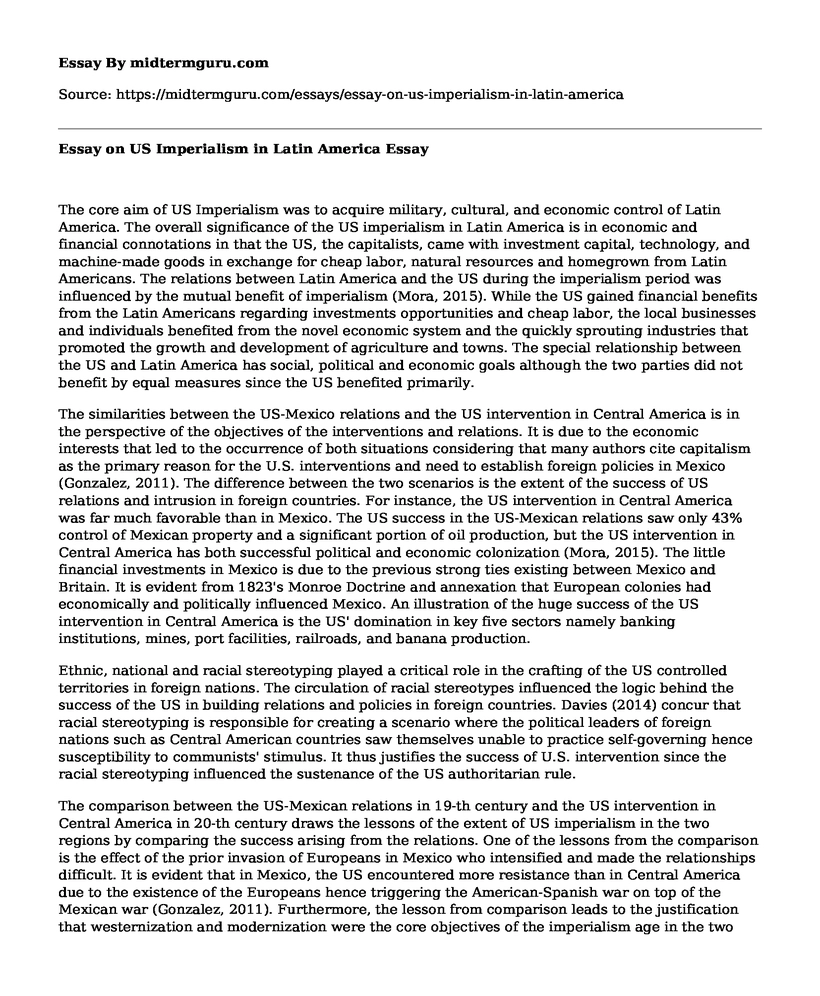The core aim of US Imperialism was to acquire military, cultural, and economic control of Latin America. The overall significance of the US imperialism in Latin America is in economic and financial connotations in that the US, the capitalists, came with investment capital, technology, and machine-made goods in exchange for cheap labor, natural resources and homegrown from Latin Americans. The relations between Latin America and the US during the imperialism period was influenced by the mutual benefit of imperialism (Mora, 2015). While the US gained financial benefits from the Latin Americans regarding investments opportunities and cheap labor, the local businesses and individuals benefited from the novel economic system and the quickly sprouting industries that promoted the growth and development of agriculture and towns. The special relationship between the US and Latin America has social, political and economic goals although the two parties did not benefit by equal measures since the US benefited primarily.
The similarities between the US-Mexico relations and the US intervention in Central America is in the perspective of the objectives of the interventions and relations. It is due to the economic interests that led to the occurrence of both situations considering that many authors cite capitalism as the primary reason for the U.S. interventions and need to establish foreign policies in Mexico (Gonzalez, 2011). The difference between the two scenarios is the extent of the success of US relations and intrusion in foreign countries. For instance, the US intervention in Central America was far much favorable than in Mexico. The US success in the US-Mexican relations saw only 43% control of Mexican property and a significant portion of oil production, but the US intervention in Central America has both successful political and economic colonization (Mora, 2015). The little financial investments in Mexico is due to the previous strong ties existing between Mexico and Britain. It is evident from 1823's Monroe Doctrine and annexation that European colonies had economically and politically influenced Mexico. An illustration of the huge success of the US intervention in Central America is the US' domination in key five sectors namely banking institutions, mines, port facilities, railroads, and banana production.
Ethnic, national and racial stereotyping played a critical role in the crafting of the US controlled territories in foreign nations. The circulation of racial stereotypes influenced the logic behind the success of the US in building relations and policies in foreign countries. Davies (2014) concur that racial stereotyping is responsible for creating a scenario where the political leaders of foreign nations such as Central American countries saw themselves unable to practice self-governing hence susceptibility to communists' stimulus. It thus justifies the success of U.S. intervention since the racial stereotyping influenced the sustenance of the US authoritarian rule.
The comparison between the US-Mexican relations in 19-th century and the US intervention in Central America in 20-th century draws the lessons of the extent of US imperialism in the two regions by comparing the success arising from the relations. One of the lessons from the comparison is the effect of the prior invasion of Europeans in Mexico who intensified and made the relationships difficult. It is evident that in Mexico, the US encountered more resistance than in Central America due to the existence of the Europeans hence triggering the American-Spanish war on top of the Mexican war (Gonzalez, 2011). Furthermore, the lesson from comparison leads to the justification that westernization and modernization were the core objectives of the imperialism age in the two regions, the US relations was mainly geared towards influencing the colonies to embrace the western culture, government forms, and technology.
References
BIBLIOGRAPHY Davies, K. (2014). American Imperialism. New York: Springer.
Gonzalez, J. (2011). Chapter 8: Central Americans: Intervention Comes Home to Roost. In Harvest of Empire: A History of Latinos in America (pp. 129-148). New York: Penguin Books.
Mora, F. (2015, May 19). Determining and gaining U.S. influence in Latin America. Retrieved from Latin America Goes Global: http://latinamericagoesglobal.org/2015/05/determining-and-gaining-u-s-influence-in-latin-america/
Cite this page
Essay on US Imperialism in Latin America. (2021, Jun 04). Retrieved from https://midtermguru.com/essays/essay-on-us-imperialism-in-latin-america
If you are the original author of this essay and no longer wish to have it published on the midtermguru.com website, please click below to request its removal:
- China History: Deng Xiaoping and Four Modernization
- Incorporation of Competency-Based Assessment Within the Current K-12 Assessment - Research Paper
- Paper Example on NRF, NIMS, and ICS
- Weapons of Mass Destruction: A Webliography
- Paper Example on Government Electronic Surveillance
- The War in the Philippines: Sustaining American Politics Amidst Imperialism - Essay Sample
- A Struggle for American Freedom: The US Constitution - Research Paper







